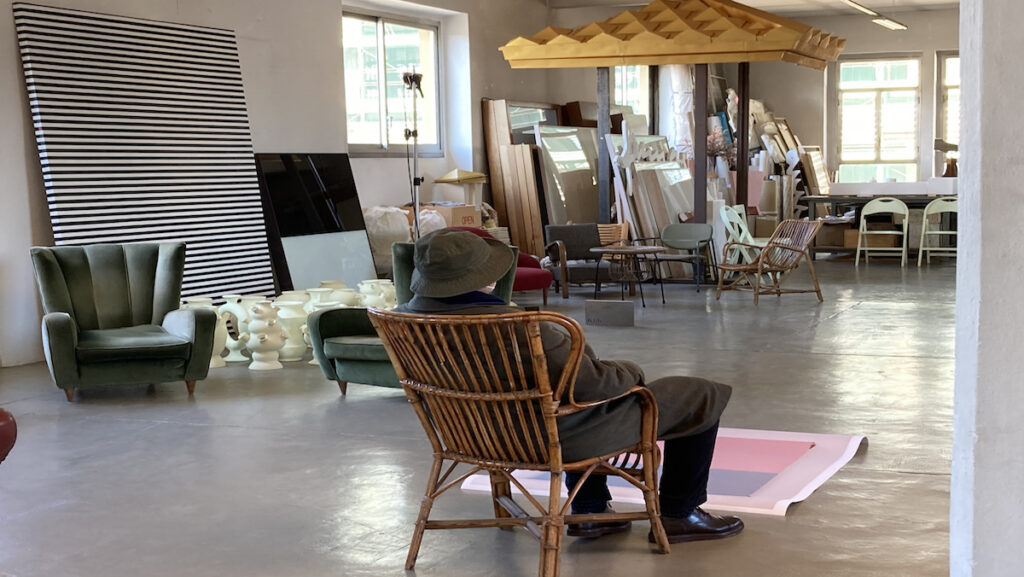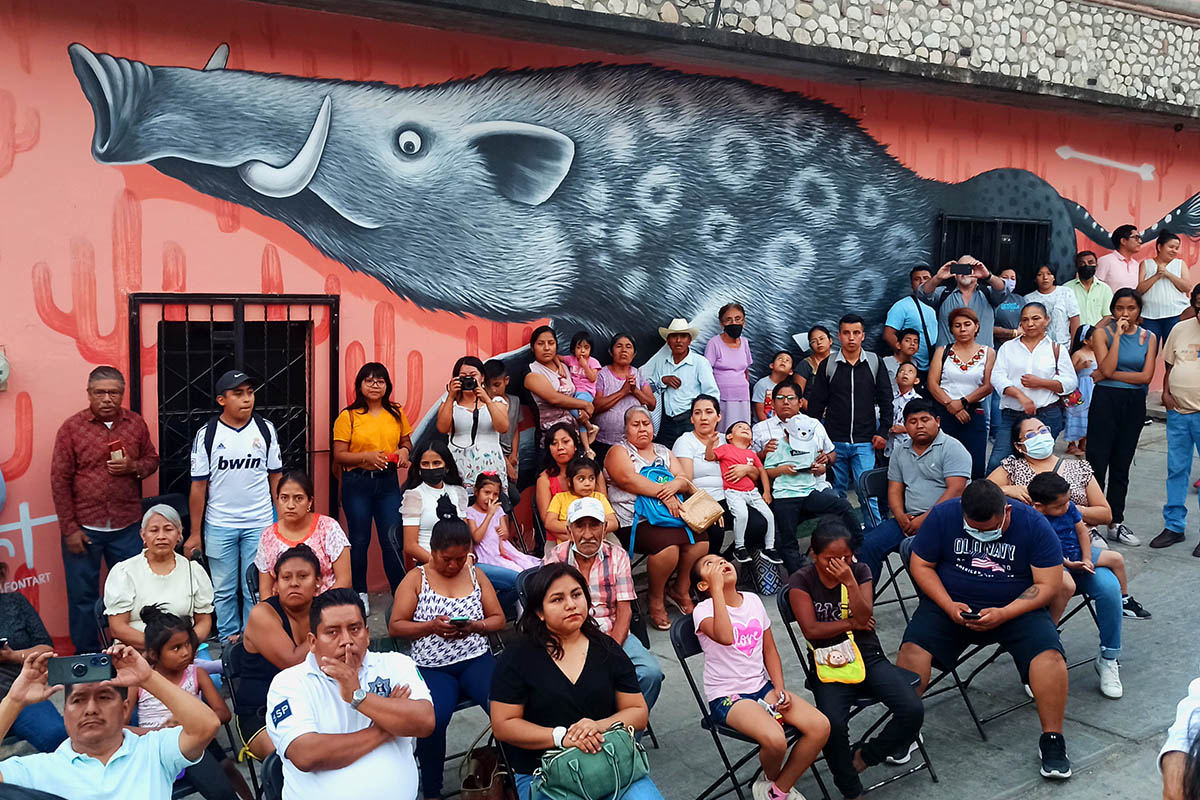
Located in an industrial complex in Barcelona, Spain B-Murals is a self-managed cultural center specializing in urban art. It is also a producer and leads the implementation of large-format murals while curating the program around them. As a pioneering project with a broad approach that combines support for the creation of mural artists through residencies, exhibitions, and the impulses of mural interventions. Run by and for the community with a high educational and reflective sense. B-Murals is one of the most unique projects in urban art discourse, with a strong ability to bring urban art closer to the public and wide audiences.
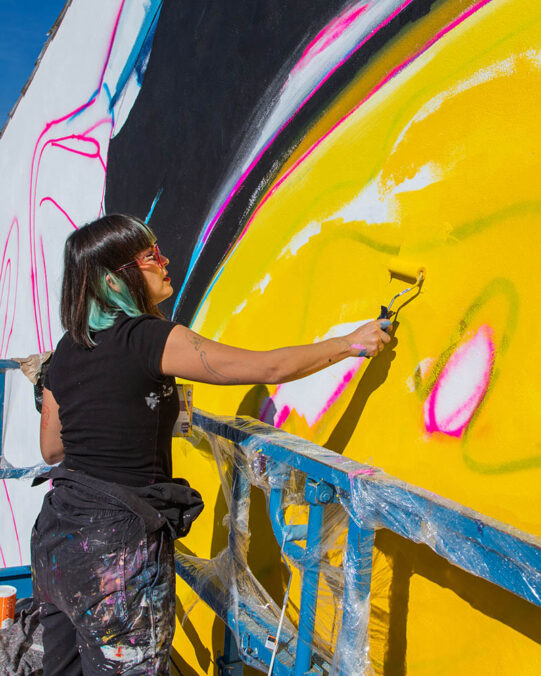
Mural art by the spanish artist Ana Barriga, at OSONA ART i MUR/ Catalunya. Photo by: Monika Plufferova 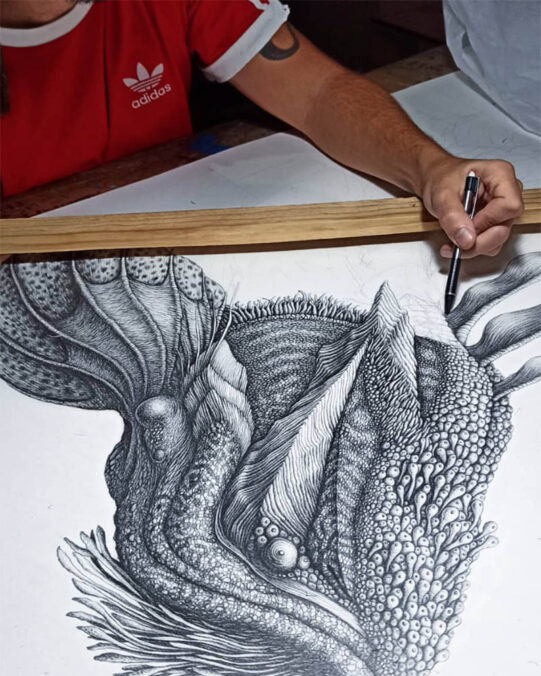
Guillem Font drawing on paper one of his creatures
Calle libre means „free street“ in Spanish and represents Central Europe’s biggest street art festival accompanied by a music program held every year in Vienna, Austria. It started in 2014 as a small festival but became an international platform for art and culture over the years. Through the Calle Libre festival, a wider audience can enjoy and be informed on the topics of nature, proportion, and the potential of street art as a form of art, which might be the most important message the festival is sending into the world.
Through the support of B-MURALS, who has joined hands with the Calle Libre Festival as a partner, and the Delegation of the Government of Catalonia to Central Europe, whose ongoing collaboration with the Calle Libre Festival since 2022- long-term envisioned.
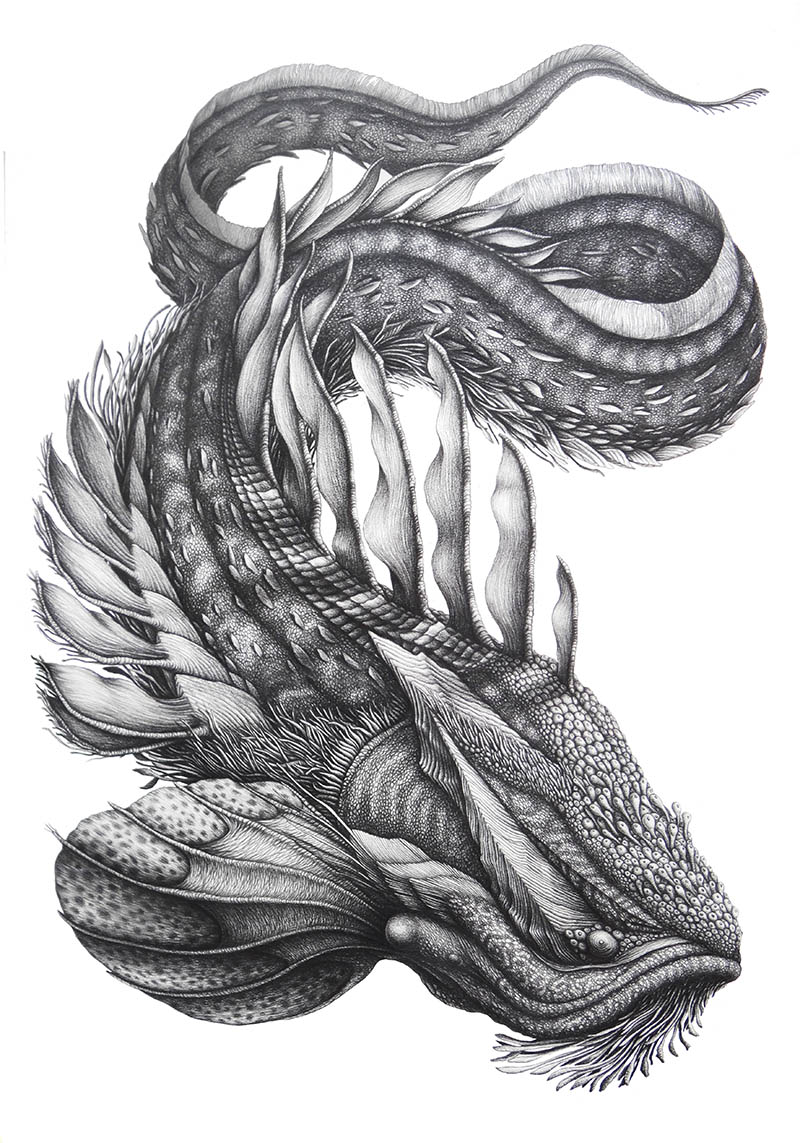
Guillem, can you tell us about your artistic background and how you came to work on large-scale murals?
I graduated in Fine Arts and Illustration. Currently, I live between Barcelona and Mexico City, where I have worked as an illustrator and co-director of the community art collective „Ruta Gràfica Mx“ (2016–2023). The other part of my time is dedicated to personal production as a visual artist, developing my own style in different disciplines such as drawing, painting, illustration, printmaking, and animation. My artistic interests have led me to explore the fields of scientific illustration and science fiction. The style that characterizes me has much to do with my passion for the study of textures and organic forms of the different species of animals and plants that inhabit our planet, with which I have developed a particular imagination that I capture in small and large format proposals.
I have made mural interventions for urban art festivals, institutions, and brands in Spain, Germany, Italy, Macedonia, Morocco, Puerto Rico, Miami, Mexico, Guatemala, and Colombia. I’ve also had group and solo exhibitions in the Iberian Peninsula, Italy, and Mexico.
What inspires you to create art on such a grand scale, particularly in an urban setting?
Guillem: Since I was a child, I have lived in the Catalan cultural scene, full of traditions, festivities, and performing arts. My parents have dedicated all their lives to cultural management and cultural policies, and I think that has had a great impact on me.
I remember they constantly took me to the popular celebrations of Barcelona and other Catalan towns and cities, where giants and the popular fiberglass bestiary coexisted with humans, castles, and music.
When I would go with my parents to the theater, the performances would have such an impact on me and make me travel to different realities. I was especially impressed by „La Fura dels Baus“ and „Comediants,“ who took their shows out of traditional forms and brought them to public space. Drums, dance, fire, and huge mythological beings played by the actors provoke the audience in many ways. I dreamed of being one of them when I grow up.
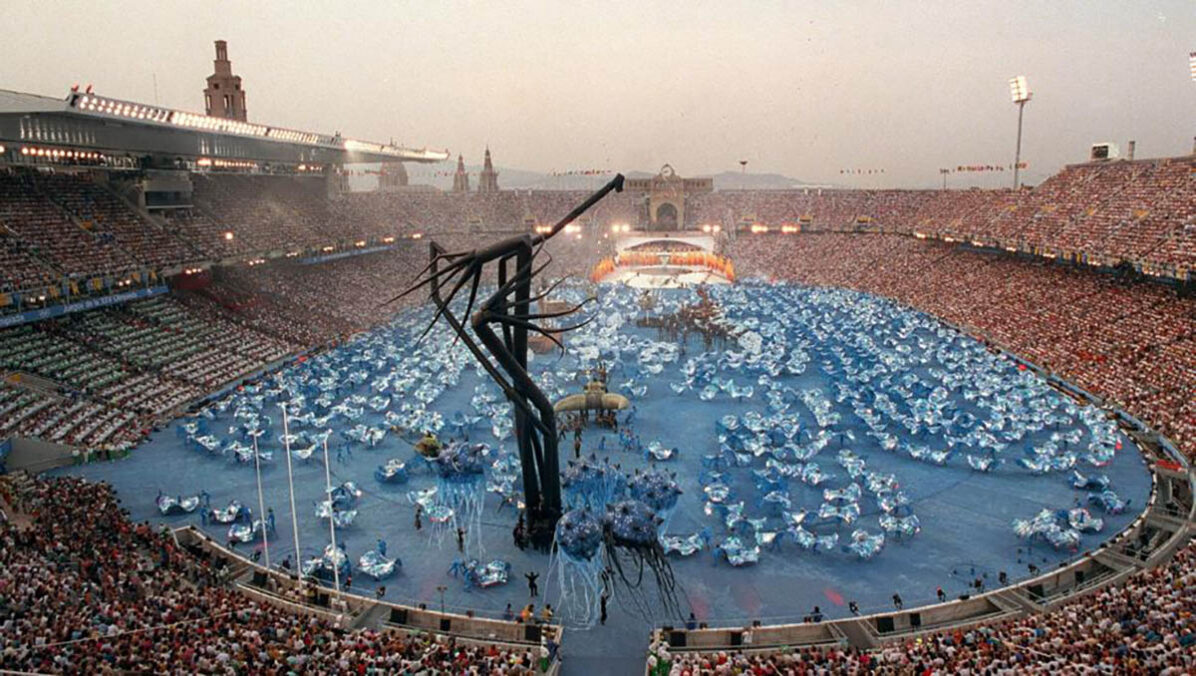
Next to it, I started surrounding myself with science fiction, fantasy movies, and books, and I started trying to immortalize those parallel realities by drawing them on paper. All of this together has shaped my style until now. During my studies, I remember the moment when I realized the need to bring my art to the urban environment and to create it in larger formats, filling the streets. My giant hybrid beings, animal-plant mixtures, aim to break the routines of passersby and bring them to other realities. With every project, I try to adapt my work to situations and allow viewers to make connections. My work is most of the time in gray tones; it serves to give the viewer a visual rest from the hyper-colorful society we live in through social media, television, etc. I try to comment on society and its increased movement of humans away from nature.
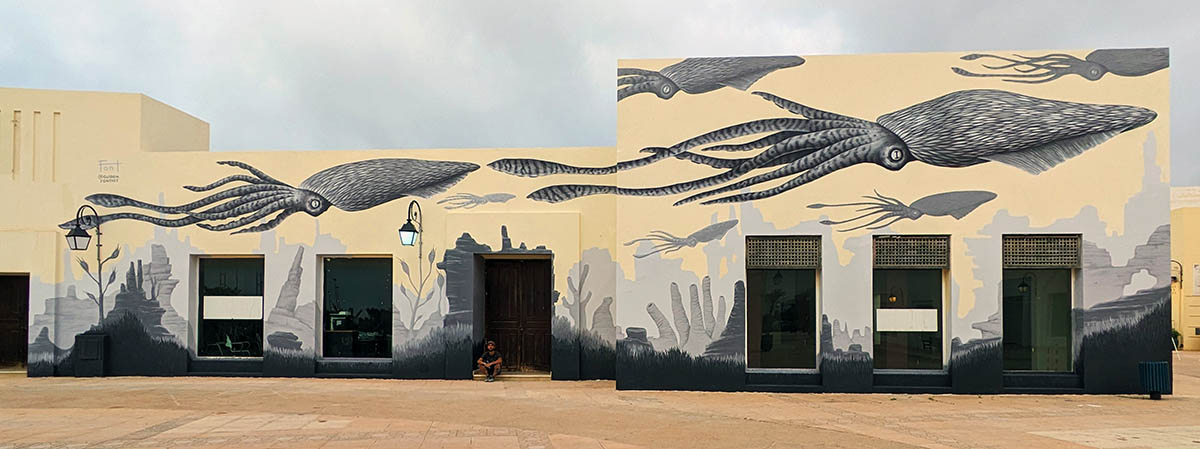
mural made in Saïdia Happy Walls Festival, Morocco 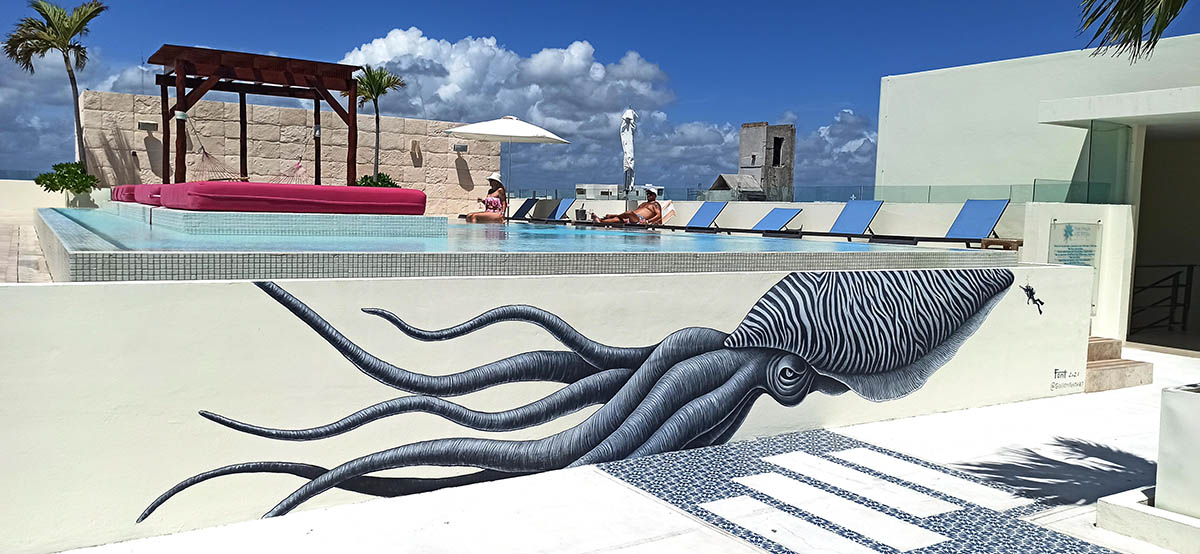
Mural made in Cancún, México
What role does drawing as an everyday practice play in your life?
Guillem: As I said before, drawing has been the basis of all my work. From drawing are born all the ideas that I later transfer to painting in public spaces, painting on canvas, illustration, engraving, etc. Drawing every day, or as much as time allows, made me break a lot of fears and pushed me to experiment and be faster in the execution of my ideas. When I work on my personal projects, I have a more therapeutic and meditational approach. I really leave my intuition to guide me through textures and silhouettes that start to form beasts that live in me. I am studying them carefully and exploring them as a scientist.
How do you ensure that your mural resonates with the local community and reflects the unique characteristics of the environment?
Guillem: The proposal I have made for the Calle Libre Festival is a reinterpretation of the flower „Edelweiss,“ the national flower of Austria. A mural of the flower will appear in the district of Ottakring, known for its diversity and multiculturalism. Edelweiss has been transformed and has bloomed full of textures that refer us to different animal species from other parts of the world. It is no longer the snow flower; it is a different version full of textures from other latitudes, a nod to the mix of cultures, tones, and aromas from different parts of the world that converge in this neighborhood of Vienna. The proposal also refers to the evolution of the Calle Libre Festival and its growing impact on culture and urban art in Europe. With the mural „Edelweiss,“ I am trying to remind the audience of the diversity of the ecosystems on our planet. and send a message of care for our surroundings.
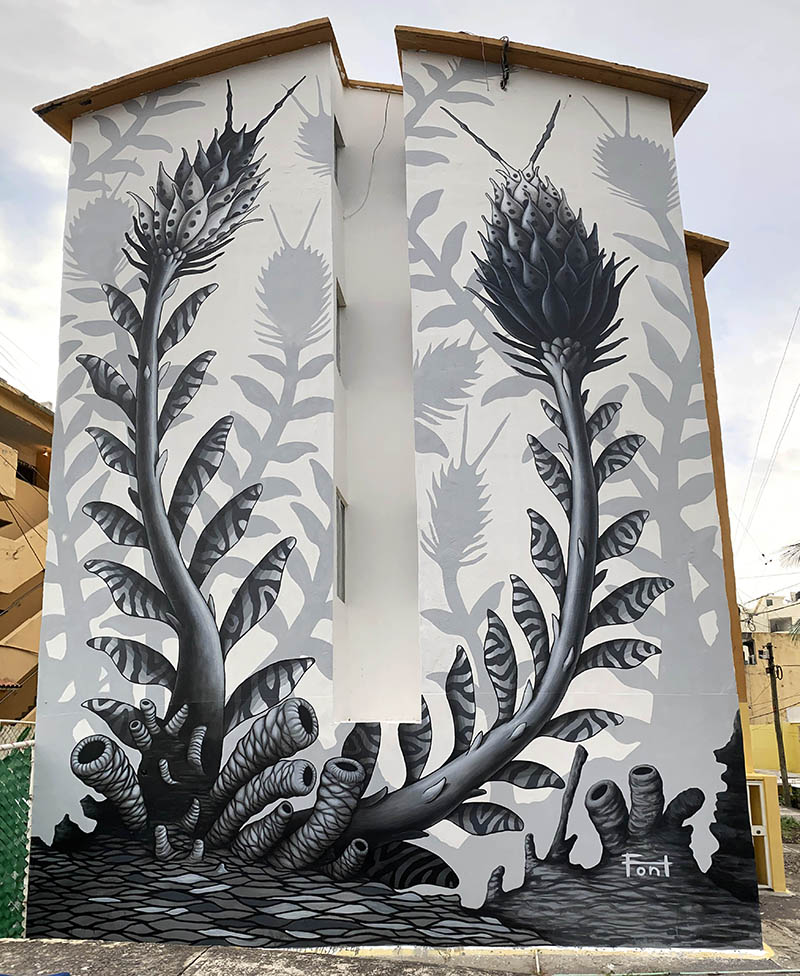
Can you share any memorable experiences or challenges you’ve experienced while working on large-scale murals in the past?
Guillem: Each mural has been a memorable experience for me. I remember the experience of painting at the „Cuicatlan Mural Festival,“ located in the middle of the Tehuacan-Cuicatlan Biosphere Reserve in Oaxaca, México. a UNESCO World Heritage Site. One of the many incredible places we were able to visit during the festival was a cave called the „Cueva de las Manitas,“ discovered in 1970. It is home to one of the most important rock art finds in Mexico. a mural more than 10,000 years old, with hundreds of human hands of different carvings accompanying silhouettes of animals that apparently represented the hunting prey on which the survival of the cave’s inhabitants depended. Even today, there are still some families in the reserve that survive by hunting deer or wild boar for their own consumption. The mural I made on that occasion refers to those first settlers who inhabited the reserve and the animals that allowed them to survive.
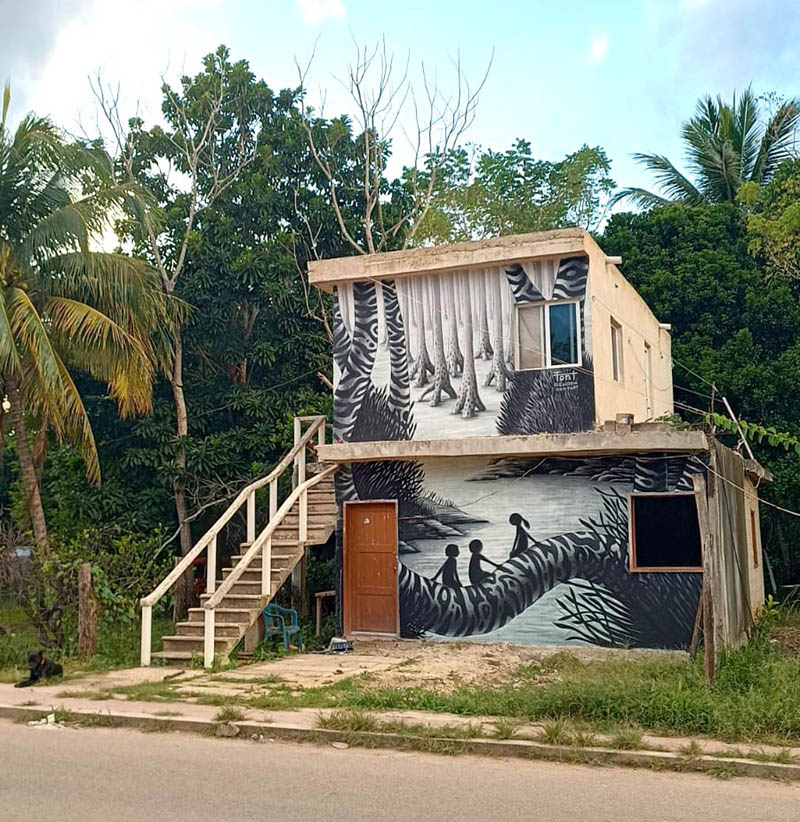
One of the first things that I did on a large scale in collaboration with another colleague in Mexico City It was during the festival „Central de Muros“ that was held for a few years in „La Central de Abastos,“ the largest market in Latin America. Thousands of people pass through there every day, distributing food all over Mexico. Each artist was signed one of the 25-by-10-meter walls located in different hangars in the market. At first, the vendors did not understand our process, but later, when all the artists were advancing the murals, they started approaching with questions and started participating in some decisions of the creative process. Later, vendors kept the murals neat and clean, and they competed among themselves over which was the best piece.
In the middle of the jungle in Quintana Roo, Mexico, I had the wonderful opportunity to paint a mural on the wall of a small house in the town of Solferino. The humble young migrant couple from Chiapas, along with their three children, warmly welcomed me, and the children eagerly watched the mural’s progress every day. Despite the financial hardships they faced during the pandemic, they managed to survive and support their family, and in gratitude, I painted the silhouettes of their children on the mural, which filled them with joy when they discovered it.
I am very grateful to have been able to travel, paint, and meet people from such different realities.
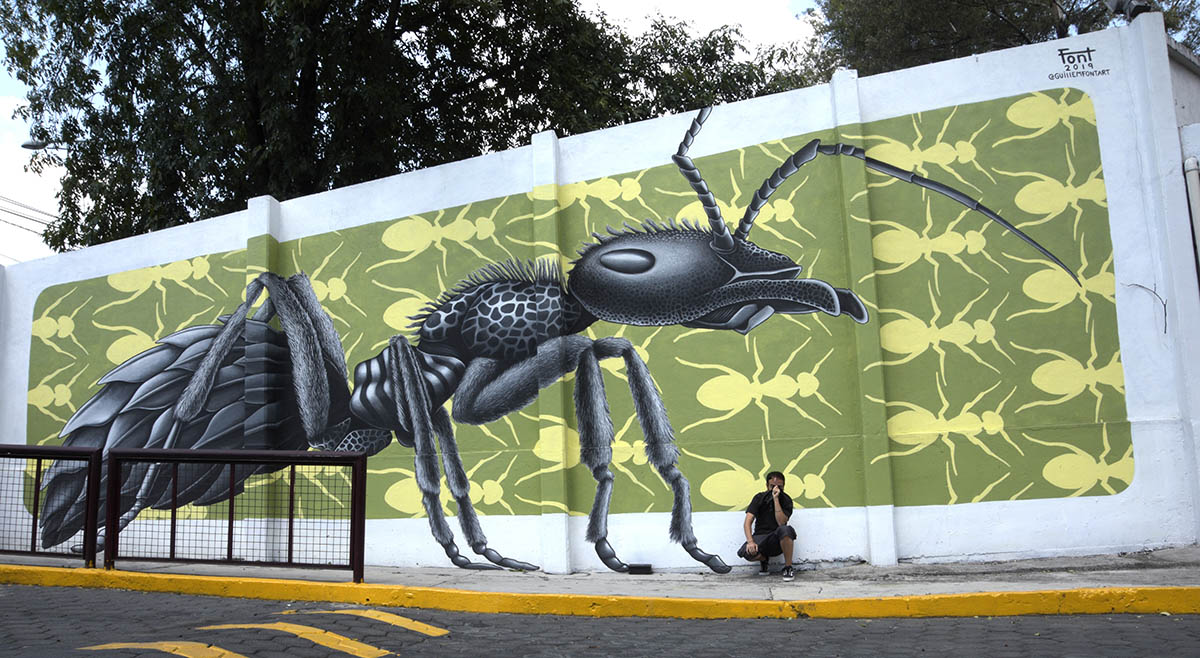
How do you envision your mural contributing to the overall atmosphere and aesthetic of the Calle Libre festival?
Guillem: My proposal for the festival aims to offer a fresh perspective to the diverse array of artists who have participated in the past. The eclectic selection of proposals and the opportunity to witness various creative processes evolving in different directions are things I truly appreciate. Although I haven’t been to Vienna myself, my colleagues who have painted in „Calle Libre“ have spoken highly of the experience, and I am eagerly looking forward to living it myself.
You have collaborated with other artists in the past; would you like to mention one special collaboration? Do you plan to involve others in the creation of your mural for the festival?
Guillem: One special collaboration I would like to mention is the project Ruta Gràfica Mx, which I created with my partner Luisa Estrada, a printmaker and drawer from Mexico City. Ruta Gràfica Mx is a participatory art project featuring an itinerant printmaking workshop, housed in a van equipped with all the necessary tools for drawing, carving, inking, and printing collectively. Over the years, we have collaborated with diverse communities, schools, cultural centers, universities, NGOs, and more, creating large format engravings through workshops held at different points along our routes. You can find us on Instagram to learn more about the project.

Your participation in the Calle Libre Festival is also supported by the Delegation of the government of Catalonia to Central Europe. Why is it important for you to support trans-regional projects? What do you think?
Guillem: First of all, I think it is very positive that a governmental organization pays attention to urban art that had been neglected in the past but later had a great explosion and important recognition in some countries and must be placed at the deserved level. It is important because it means showing Catalan urban art in the European showcase, which brings many opportunities. The interaction with artists from all over the world is always a mutual enrichment and, therefore, an enrichment for the Catalan artists who participate and for the Catalan culture.
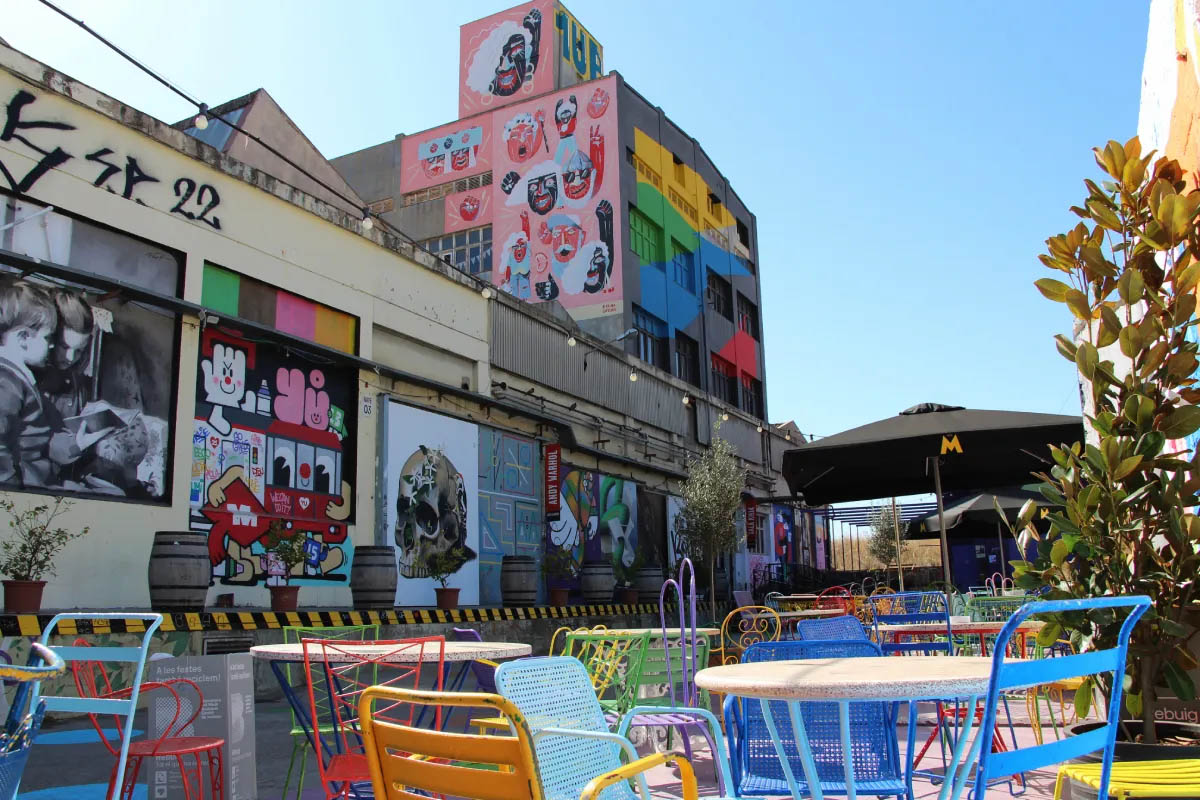
B-Murals: The work of government platforms and the cultural policies of each country is extremely important for the dissemination and support of local artists, to promote contemporary local heritage, and to allow contact and exchange of techniques, styles, and people outside of their natural space. The impulse given by the Government Delegation of Catalonia not only benefits artists but also promotes art entities: their projects, their way of working, and the new channels of dialogue that are created. We believe that these are not only very positive and necessary initiatives but also a few that should be carried out more often.
Being able to be present at Calle Libre (Vienna) as curator is the opportunity to bring a whole legacy and way of thinking about urban art from Barcelona and take out to a new context a group of artists and projects that we carry out on a daily basis in a context that is ours, that of Barcelona.
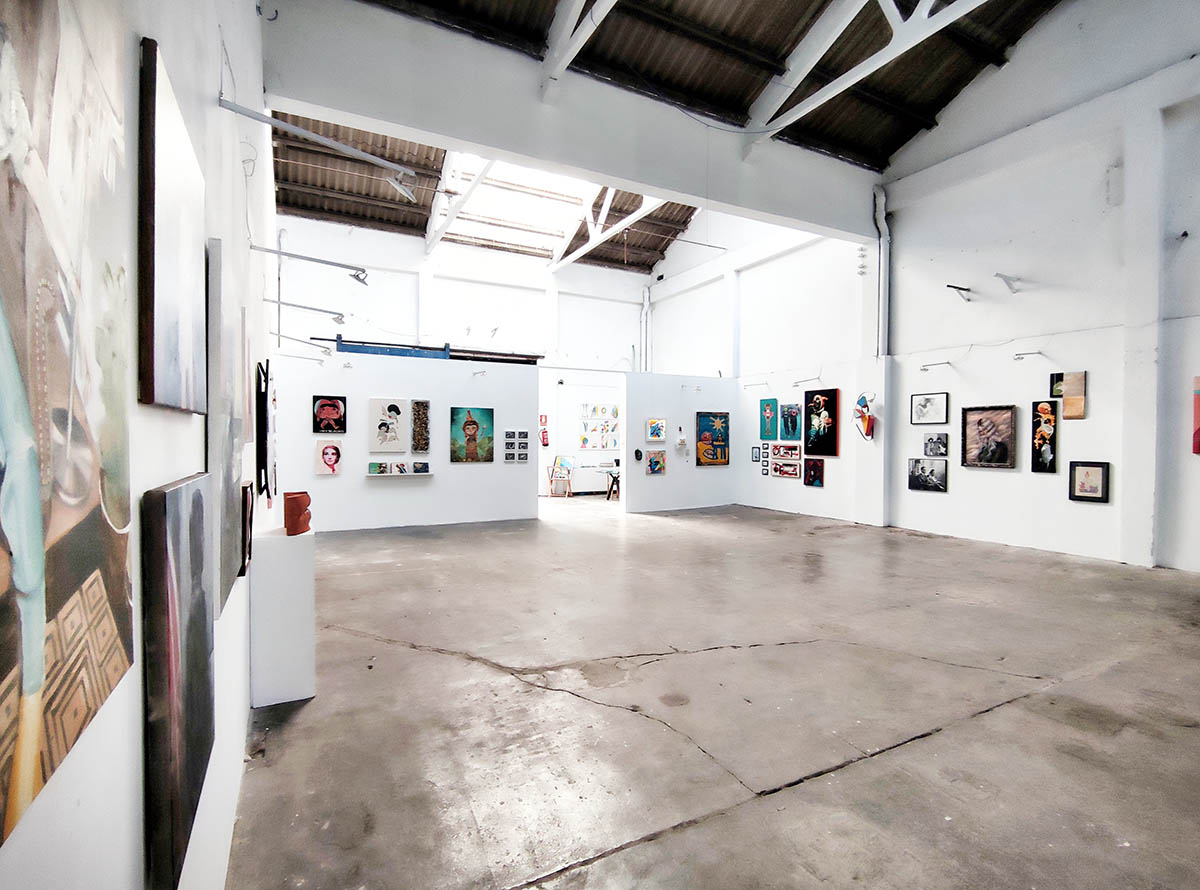
What are your thoughts on the role of urban art festivals in promoting cultural diversity, creativity, and community engagement?
B- Murals: The first Urban Art festivals were more of a spark of enthusiasm to collect a bunch of the most famous artists on the international scene; it was a struggle to have certain names that represented their program. With the growth and maturity of these festivals and the abundance of programming in small and large cities, urban art festivals became an important space for artists to get together with communities and cities, as well as the right space for participatory processes and identity development.
Festivals are increasingly becoming platforms for the visibility of artists, offering themselves almost as a living academy of styles, techniques, and the diversity of artists who move around the world, leaving their imprint in the public space. They result in living catalogs of creativity that are not only the calling card of the artist who paints them but also the deepest reflection of the community that inhabits that wall: its history and stories, traditions, and defining lines are a source of inspiration for most artists, reinforcing, giving continuity, and feeding their most recent and current identity. In fact, muralists have been affirmed in many places with important testimony and the revaluation of identity and historical traces in many communities.

Barcelona is also known for its great street art scene. A very well-known art and cultural center is B-Murals. Can you tell us how it is organized? Why should everyone definitely visit it?
B-Murals: Barcelona has been one of the most important cities in the urban art scene, although it is currently fighting hard against public space management policies. Spaces like B-Murals emerged as small oases that physically sit in a limbo of private space but are open to the public, allowing an old factory complex, which boasts multiple walls, to be filled with murals and art. They are 6000 m2 with more than 40 murals by different artists, of which 12 or more are renewed every year. In addition to having a curator that plays with local artists and presents those based on calls, it also has great artists who have left their legacy there:
Sixe Paredes, Elian Chali, Marina Capdevila, Mina Hamada, Zosen Bandido, Sawe, Ivan Floro, Nicolàs Romero (Ever-Always), Zane Prater, Eloise Gillow, Jofre Oliveras, Socatoba, Sebastian Waknine, Turkeza, Zurik, Elisa Capdevila, Miquel Wert, Yubia, Miquel Falgàs, EdOner, Azpeger, Tim Marsh, Mario Monkey, among many others. Quite close, and also produced by B-Murals, you can see the mural of Ana Barriga and Axel Void (Barrio de la Sagrera) a 3-minute walk away. But we are not left alone with the mural offer: B-Murals is deployed in two main spaces: a big space for international residences, specialized in artists who develop artistic projects in dialogue with the public space; and a gallery aimed at this same area, to give visibility to artists whose main focus is working on the street but who at the time also have studio work. A project designed ultimately to open up to the public as a focus of dissemination and support for the most contemporary urban art. The visit to the complex is totally free.
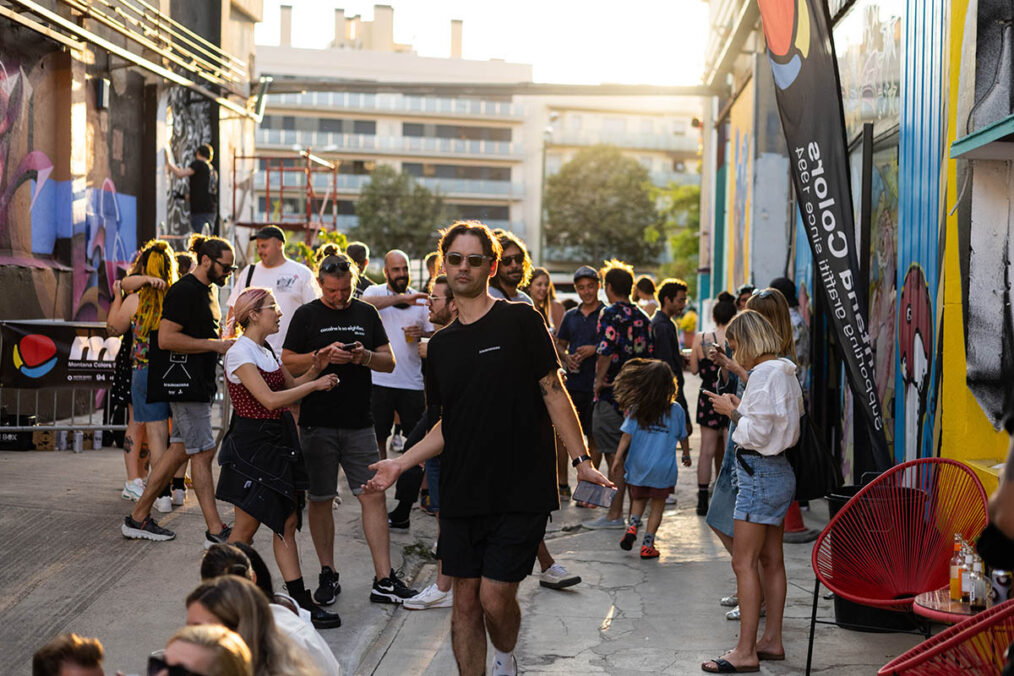
Outside area of B-Murals Gallery, during 5# Tramontana Street Art magazine launch. Photo by: Tramontana 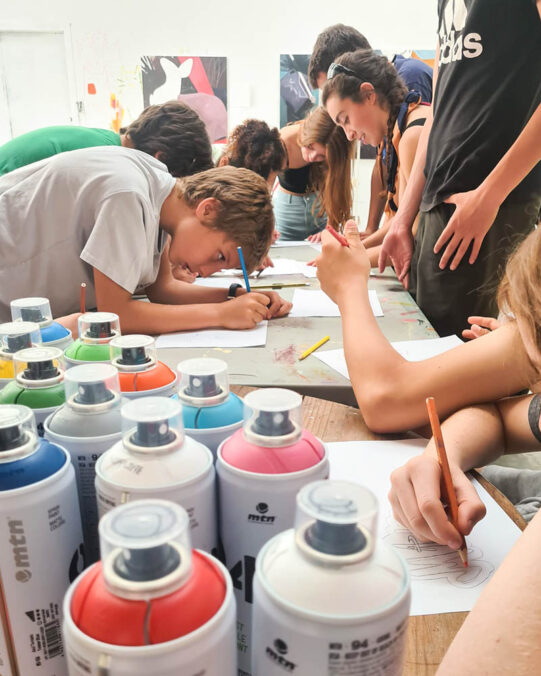
Workshop organized for schools – B-Murals Art Education Program. Photo by: Ana Manaia 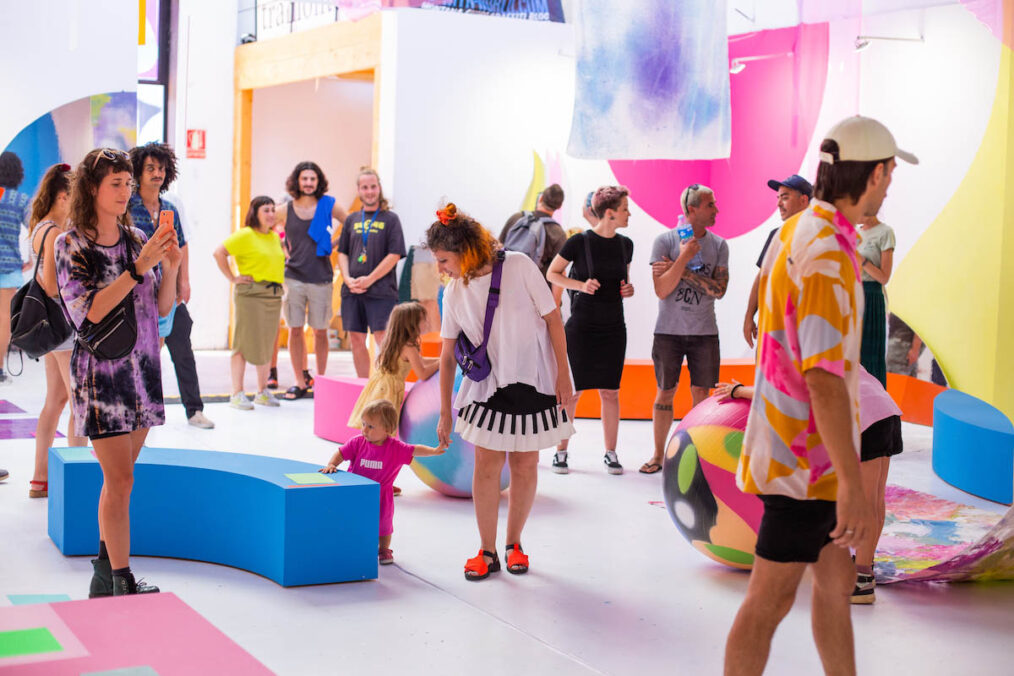
inauguration of the art installation „EnTrance“ in B-murals gallery, by the artists Kenor and Mina Hamada. Photo by: Monika Plufferova
Finally, what are your expectations and aspirations for participating in this urban art festival, both personally and professionally?
Guillem: Whenever I have attended festivals, I have had very enriching experiences. On the one hand, the fact of immersing yourself in a reality different from your own and the responsibility of creating a work of art in a public space that you do not know, which in turn is the space of coexistence of a community, is a challenge that you digest as you spend the days in the place and that can modify the final results. On the other hand, the fact of living together and being able to meet artists from other parts of the world who have lifestyles similar to yours creates an artistic community at a global level and allows you to learn a lot and see other ways of working, which are always enriching. I would like very much that painting in Calle Libre would give me the opportunity to meet new people with whom I could collaborate in the future on new projects or just become friends.
B-Murals: Calle Libre is the perfect moment and context to unite Mediterranean street art with Northern Europe, a meeting point where the most diverse links and new projects for the future can arise.
Calle Libre
27th July till 5th August
www.callelibre.at
Guillem Font – www.instagram.com/guillemfontart/
B-MURALS. Located in an industrial complex in Barcelona, Spain B-MURALS is a self-managed cultural center specializing in urban art. As a pioneering project with a broad approach that combines support for the creation of mural artists. Through residencies, exhibitions, and the impulses of mural interventions. Run by and for the community with a high educational and reflective sense. B-MURALS is one of the most unique projects in urban art discourse, with a strong ability to bring urban art closer to the public and wide audiences.
Address and contact:
Carrer Ferran Turné, 11, 08027 Barcelona, Spanien
www.bmurals.com
www.instagram.com/b.murals



